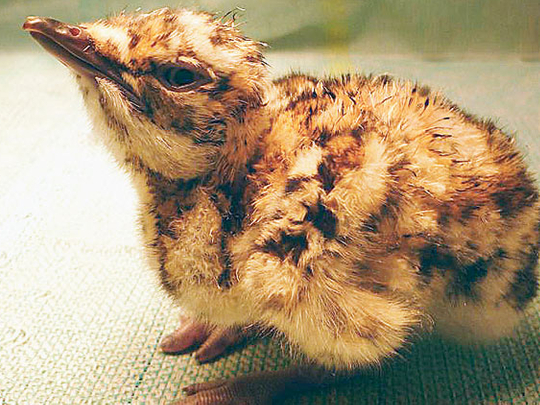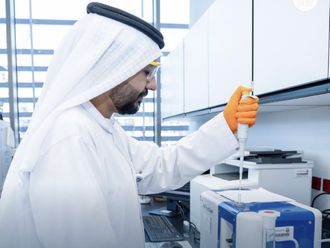
Abu Dhabi: On an island tucked away from the sights of the public and protected by restricted access, a team of scientists have been working relentlessly for three years in the hope of bringing to life a houbara bustard that would have a chicken as a mother.
The mission's objective was to produce a houbara from a chicken egg, and thus propagate the endangered houbara population through the commonly available domesticated chickens.
While this may sound straight out of science fiction, the project finally tasted success last week.
"A houbara chick was born out of a chicken egg," Dr T.S. Thiyagasundaram, the Indian scientist who headed the research told Gulf News in an exclusive interview.
The research was carried out by the Management of Nature Conservation section at the private department of President His Highness Shaikh Khalifa Bin Zayed Al Nahyan.
Success came after many failed attempts, he said.
"Scientists carefully harvested live embryos from a houbara egg, identified its germ cells [the reproductive cells] and injected this into a chicken embryo. The chicks hatching out will look like chickens but are likely to have reproductive cells of a houbara, and are called chimeras. When these hens mature, they are inseminated with houbara semen. The successfully hatched chicks will be pure houbaras," he explained.
Genetic variability
While in the wild, one houbara egg would just mean one houbara chick, this technology called interspecific chimeric technology will help get many chicks from one egg in addition to maintaining genetic variability.
One houbara egg will contain a few thousand germ cells which can be injected into more than one chicken embryo. These embryos grow to produce at least a few good chicken chimeras. When they mature, they lay about 180-200 eggs in one year which are likely to result in the production of several houbaras.
"With the first houbara chick hatched through interspecific chimeric technology, the technology has now come of age," said Dr Thiyagasundaram.
Application of this principle may help save many endangered avian species in future, he said.
"Our technology most importantly proves that a foreign embryo can be supported by chicken albumen and yolk, and chicken shells, asserting that the commonly available chicken eggs can be suitable recipients for some other avian species."
Now that the principle has been successfully demonstrated, this "breakthrough finding" will pave way for new research methodologies for saving many endangered avian species in the course of time, according to Dr Robert Etches, Chief executive officer and co-founder of the US-based research organisation Crystal Bioscience. He got involved in the project about two years ago.
The first phase of the project began nearly four years ago with research to standardise the technology and to confirm the suitability of chicken egg shell as a "universal recipient" supporting embryo growth and hatching of many different avian species like ducks, geese, quails, partridges, sandgrouses, guinea fowl and pigeons.
But it was too risky to use houbara eggs in the initial phase, Dr Thiyagasundaram said.
Precious resource
"Since houbaras are endangered, each of their eggs is considered as a highly precious resource, which we couldn't experiment with," he said
So, in the second phase, they chose the Japanese quail as a model animal to show that they could get back pure chickens by generating quail/chicken chimeras using germ-cell technology. After months of work, another milestone was achieved when the team finally able to get chickens from quails.
DNA analysis of these chicks from quails revealed that they are indeed chickens.
Encouraged by the successes in Ex Vivo Avian Embryo Culture, surrogate shell techniques and results of Japanese quail trials the research team gained confidence to extrapolate these results to handle houbara embryos culminating in the remarkable achievement.
But this is only the beginning of a long journey of conservation, scientists said.
Process: Research principle
- Collection of totipotent germ cells from early stage houbara embryos and preservation.
- Early stage embryos of chicken are injected with the houbara germ cells using micro injection techniques.
- The chicks hatching out will look like chicken but have houbara gonadal cells inside their organs.
- At maturity, when such a hen starts laying eggs, she is inseminated with houbara semen.
- Few of the eggs are fertile.
- The successfully hatched chick will be a pure houbara.
(Source: Private department of the President of UAE.)












